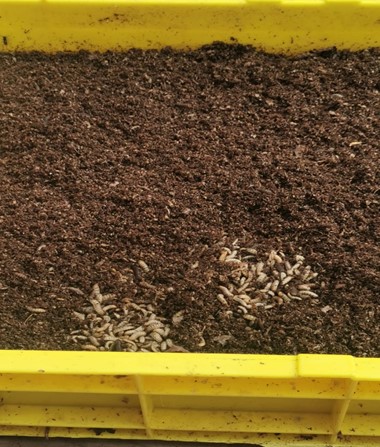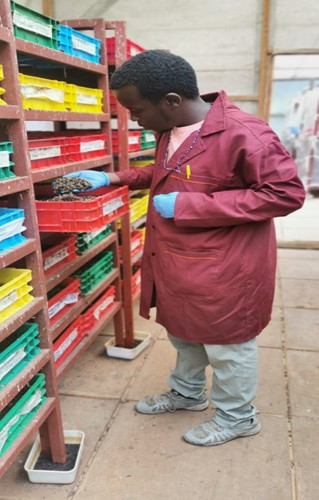Exploring the Benefits and Applications of Black Soldier Fly Farming
Harnessing the Power of Black Soldier Fly Farming: A Scientific Perspective
Revolutionizing Sustainable Agriculture
Global food security challenges and environmental degradation have underscored the importance of sustainability in agriculture. Recently, sustainable agriculture has focused more on innovative methods that promote a circular economy. One innovative approach gaining traction is the cultivation of black soldier flies (BSF), a small insect with remarkable potential for revolutionizing sustainable farming.
Black Soldier Fly: What is it?
Hermetia illucens (black soldier flies) are remarkable insects known for their rapid growth, voracious appetite at the larval stage, and efficient waste conversion. The adults have spongy mouths and drink only water. As a result, they do not produce a buzzing sound nor transmit diseases.
In adult males, the abdomen is brown, and the tail is shorter, while in females, the abdomen is black, and the tail has a scissor-like structure known as the ovipositor, used to lay eggs. The females are attracted to a rotting smell, such as manure, used as bait to lay eggs. A green fluid on the female’s thorax releases volatiles, attracting other females to lay eggs in the same place.
As a result of its life cycle, it offers unique opportunities for agricultural and environmental benefits. The larvae of black soldier flies feed on a wide array of organic materials, such as manure, kitchen scraps, and agricultural byproducts, transforming them into nutrient-rich organic fertilizers called frass. This feature alone offers a sustainable solution to waste management.
The Science Behind Black Soldier Fly Farming
Several studies have provided empirical evidence supporting BSF farming. Let’s dive into the scientific research behind black soldier fly farming and its potential to transform sustainable agriculture.
Waste Management and Nutrient Cycling
Research has shown that BSF larvae efficiently convert organic waste into protein-rich biomass and a nutritious by-product known as frass. They break down various organic materials, including plant matter and food scraps, into a high-protein, fat-rich substance that can feed livestock or aquaculture. The process takes only five weeks compared to traditional composting methods. This reduces the burden on landfills while producing valuable nutrients.

Black Soldier Fly Larvae converting agricultural waste into fertilizer
Environmental Impact
Black soldier fly farming requires fewer resources than traditional livestock feed production. These insects thrive on organic waste that would otherwise contribute to greenhouse gas emissions.
By diverting this waste to BSF farms, we mitigate methane production and reduce the overall carbon footprint.
Soil Enrichment and Crop Productivity
In addition to feeding larvae, the leftover residue can be composted to create a nutrient-rich soil amendment. The organic fertilizer improves soil quality, increasing yields and promoting healthier crops. Organic fertilizers produced by black soldier fly farming are sustainable alternatives to synthetic fertilizers, increasing soil biodiversity and reducing chemical use.
Sustainable Protein Source
Researchers from the International Centre of Insect Physiology and Ecology headed by Dr. Chrysantus Tanga have conducted an analytical study that demonstrates BSF larvae as a potential source of protein. The dry weight of BSF larvae contains 50% crude protein and 35% essential fatty acids. Because of their nutritional profile, they can be used as an alternative source of protein to soy and fishmeal in animal feed.
According to another study, poultry-fed BSF larvae-formulated meals showed improved overall health and were protected against harmful microorganisms by beneficial bacteria. It reduces the use of antibiotics in a world where antibiotic resistance is becoming a leading concern.
By incorporating BSF larvae into animal diets, feed efficiency is improved, while overfishing and deforestation caused by soy cultivation are addressed. Animal feeds, poultry feeds, and aquaculture feeds can be viably formulated with BSF.
The Challenges and Prospects for The Future
Black soldier fly farming has promising potential, but it is not without challenges. The cost of setting up infrastructure has proven to be quite a challenge for beginners.

A participant undergoing free training on BSF farming at ICIPE Duduville Campus, Kenya
More research and investment are needed to scale up production, ensure regulatory compliance such as obtaining permit approvals, and optimize larval growth.
There is also a lack of a clear and standardized policy framework when it comes to raising and selling Black Soldier fly products.
Additionally, public perception and acceptance of insects as a food or feed source must be addressed for widespread adoption.
Conclusion
The scientific evidence supporting black soldier fly farming as a sustainable agriculture solution is compelling. As the world faces the challenge of feeding a growing population while reducing its environmental impact, black soldier fly farming emerges as a promising solution that requires further research and implementation into mainstream agriculture.
The practice of black soldier fly farming aligns with the concept of a circular economy, in which waste is converted into resources to benefit agriculture as well as the environment. As research progresses and technologies evolve, the potential for black soldier fly farming to revolutionize sustainable agriculture continues to expand.
By harnessing the power of these hardworking insects, we can make our food production systems more sustainable, resource-efficient, and environmentally friendly. Black soldier fly farming has been highlighted as a silver lining in the ongoing scientific research and collaborative efforts to turn an agricultural system into a more sustainable, resilient one.
References:
Cover picture credits: https://www.wur.nl/en/article/farmed-insects-for-sustainable-food-systems-2.htm
https://patents.google.com/patent/WO2015013826A1/en
https://www.ccacoalition.org/news/cycling-limas-organic-waste-black-soldier-fly-technology#:~:text=BSF%20technology%20has%20been%20shown,of%20other%20options%20like%20composting.
https://www.frontiersin.org/articles/10.3389/fpls.2020.574592/full#:~:text=Application%20of%20BSF%20frass%20fertilizer,respectively%2C%20but%20not%20significantly%20different.
https://www.nature.com/articles/s41598-019-46603-z#:~:text=The%20dry%20weight%20of%20Black,of%20fish%20and%20shrimp27.
https://www.nature.com/articles/s41598-022-20736-0
https://www.sciencedirect.com/science/article/pii/S0959652622033789
https://www.sciencedirect.com/science/article/abs/pii/S0959652619306791
https://www.wageningenacademic.com/doi/abs/10.3920/JIFF2021.0013
Further reading:
Choosing the right species for mass production of insects as animal feed










































































